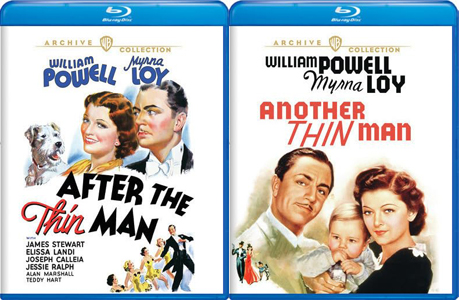With his novel “The Thin Man” (1934), Dashiell Hammett switched protagonists from workaholic, down-and-dirty sleuths to a detective who retired at a young age and didn’t want to be dragged into cases. Nick Charles would rather make a quip and have a scotch than solve a mystery (although he begrudgingly does so when asked by someone in his circle). In short, Hammett moved from hardboiled to softer-boiled.
And the “Thin Man” movie took things a step further, jump-starting the comedy-mystery subgenre that’s still popular today. Although the novel’s humor was hyper-emphasized by screenwriting couple Albert Hackett and Frances Goodrich, and more so by stars William Powell (as high-on-life quipster Nick) and Myrna Loy (as beautiful Nora), Hammett was on board with the vibe. This is clear from “Return of the Thin Man” (2012), which collects the story treatments for the first two sequels in an attempt to satiate Hammett geeks’ hunger for his writings.
The author himself substantially moved up in class due to the paychecks for story treatments for “After the Thin Man” (1936) and “Another Thin Man” (1939), the completion of his “Thin Man” trilogy. (Other writers would continue the saga for three more films, which I’ll review in a future post.)

“After the Thin Man” (1936)
Director: W.S. Van Dyke
Writers: Frances Goodrich, Albert Hackett (screenplay); Dashiell Hammett (story)
Stars: William Powell, Myrna Loy, James Stewart
“Another Thin Man” (1939)
Director: W.S. Van Dyke
Writers: Frances Goodrich, Albert Hackett (screenplay); Dashiell Hammett (story)
Stars: William Powell, Myrna Loy, Virginia Grey
One can imagine some of Hammett seeping into Nick Charles – who had moved up to the socialite class by marrying Nora – not only in the fiscal comparison, but also in his relative interest in the job. These two stories are very good, but not as passionate as his past work.
Like a lot of sequels, “After the Thin Man” – so lazily titled one can imagine Nick named it – is a crowd-pleaser that starts in the wake of the original’s Christmas events by reminding us that we love the spousal banter. Nick carefully wraps his booze in one of Nora’s dresses when packing. They disembark from a train back in San Francisco and are bombarded by press; Nick is nationally famous for the Thin Man case.
Mystery in the family
It’s a long time before we get to the new mystery, which features a notable guest turn by James Stewart in one of his first roles. Nora’s cousin Selma (Elissa Landi) needs help finding her missing husband, Robert (Alan Marshall), and Nora convinces Nick to help. He always comes through because he’d do anything for Nora, even though he’d never openly admit that, and even though it’s not a put-on that he’d rather not work.

“After” ends up having a good villainous plot: Marry a woman you don’t want to marry, accept money to leave her, then use that money to start a life with who you actually wanted to marry. Again, the writers and director W.S. Van Dyke (who directs the first four entries) deliver a cinematic grand finale where Nick gathers everyone in a room, hoping the culprit will slip up. (I’m proud to say I correctly suspected whodunit, then noticed confirmation via the same statement Nick notices.)
“Another Thin Man” – again a cheeky monicker — is a straight lift of Hammett’s second-to-last Continental Op short story “The Farewell Murder” (1930), with Nick and Nora replacing the Op. It’s lazy, perhaps, but also smart. And I love how the violent and grim Op-style plot darkens up the Nick and Nora saga enough to balance out the increasingly comedic side trips.
One oddity comes over in the translation: The executor of Nora’s estate – and friend of Nora’s late father – is apparently not entirely on the up-and-up. Colonel MacFay (C. Aubrey Smith) is targeted by a villain for selling him out on a co-conspiracy in the past. This means Nora associates with an unethical businessperson, and this isn’t good writing: If we’re to root for rich and sometimes insufferable Nick and Nora, we need to know their gains are not ill-gotten. At least, Hammett and the two screenwriters breeze over this part, not inviting us to think about it.
On the whole, “Another” isn’t as tight as the first two films, due to some off-point performances and comedy side trips that feature infant Nick Jr. As with “After,” “Another” features big dance-hall numbers that are not particularly Hammettian, but they are well-staged standards of the early sound era.
Kids and dogs … but no jumping of the shark
The comedy broadens as the third film goes on. We still get good one-liners, like Nora saying “I don’t know why I always take it for granted that you’re kidding” when Nick makes a joke about his theoretical womanizing. It’s hit and miss: When Nick allows Nora to tag along as he infiltrates his way into a suspect’s apartment, the comedy doesn’t land. But when Nora later gets caught in a dance with a suitor while trying to pay for information, we observe with the same amusement Nick does.
Uneven it may be, but there’s plenty to like about the third film. Lt. Guild (Nat Pendleton) – back from the first film – and Inspector Van Slack (Otto Kruger) have presence. And the big sequence with a bunch of mobsters bringing babies to Nickie’s party – while not exactly plausible — is undeniably ambitious, with real infants all over the screen.
Similarly, a tip of the cap goes to how Van Dyke features the Charleses’ dog Asta, such a fan favorite that he’s featured on the DVD covers with his owners. “After” finds him eating part of a clue, but he redeems himself in “Another” by finding a discarded murder weapon. Trigger warning for dog lovers, though: While Asta comes out unscathed, another canine is not so lucky in this film. Like I say, this drawn-from-the-Op tale isn’t as fluffy as what you’d think the Charleses would go in for.
People sensitive about the unfunny real-world problem of alcoholism might be bothered by how Nick is a such a high-functioning alcoholic. Hammett’s issues with drink are nothing to laugh at, but rightly or wrongly, some lines are so witty I can’t help it, like when Nick says in “Another”: “Come on, let’s get something to eat. I’m thirsty.”
Though imperfect, “After the Thin Man” and “Another Thin Man” never waver from “likeable” as the writers and two stars make the mix of comedy and mystery seem easier than it is. I for one am hungry for the last three entries in the Powell-and-Loy series, but not confident the replacements can keep up with Hammett, Hackett and Goodrich.
Sleuthing Sunday reviews the works of Agatha Christie, along with other new and old classics of the mystery genre.

